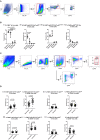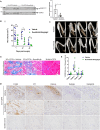Inhibition of JAK1/2 Tyrosine Kinases Reduces Neurogenic Heterotopic Ossification After Spinal Cord Injury
- PMID: 30899259
- PMCID: PMC6417366
- DOI: 10.3389/fimmu.2019.00377
Inhibition of JAK1/2 Tyrosine Kinases Reduces Neurogenic Heterotopic Ossification After Spinal Cord Injury
Abstract
Neurogenic heterotopic ossifications (NHO) are very incapacitating complications of traumatic brain and spinal cord injuries (SCI) which manifest as abnormal formation of bone tissue in periarticular muscles. NHO are debilitating as they cause pain, partial or total joint ankylosis and vascular and nerve compression. NHO pathogenesis is unknown and the only effective treatment remains surgical resection, however once resected, NHO can re-occur. To further understand NHO pathogenesis, we developed the first animal model of NHO following SCI in genetically unmodified mice, which mimics most clinical features of NHO in patients. We have previously shown that the combination of (1) a central nervous system lesion (SCI) and (2) muscular damage (via an intramuscular injection of cardiotoxin) is required for NHO development. Furthermore, macrophages within the injured muscle play a critical role in driving NHO pathogenesis. More recently we demonstrated that macrophage-derived oncostatin M (OSM) is a key mediator of both human and mouse NHO. We now report that inflammatory monocytes infiltrate the injured muscles of SCI mice developing NHO at significantly higher levels compared to mice without SCI. Muscle infiltrating monocytes and neutrophils expressed OSM whereas mouse muscle satellite and interstitial cell expressed the OSM receptor (OSMR). In vitro recombinant mouse OSM induced tyrosine phosphorylation of the transcription factor STAT3, a downstream target of OSMR:gp130 signaling in muscle progenitor cells. As STAT3 is tyrosine phosphorylated by JAK1/2 tyrosine kinases downstream of OSMR:gp130, we demonstrated that the JAK1/2 tyrosine kinase inhibitor ruxolitinib blocked OSM driven STAT3 tyrosine phosphorylation in mouse muscle progenitor cells. We further demonstrated in vivo that STAT3 tyrosine phosphorylation was not only significantly higher but persisted for a longer duration in injured muscles of SCI mice developing NHO compared to mice with muscle injury without SCI. Finally, administration of ruxolitinib for 7 days post-surgery significantly reduced STAT3 phosphorylation in injured muscles in vivo as well as NHO volume at all analyzed time-points up to 3 weeks post-surgery. Our results identify the JAK/STAT3 signaling pathway as a potential therapeutic target to reduce NHO development following SCI.
Keywords: JAK- STAT signaling pathway; heterotopic ossification; oncostatin M receptor; ruxolitinib; spinal cord injury complications.
Figures




Similar articles
-
Oncostatin M: Dual Regulator of the Skeletal and Hematopoietic Systems.Curr Osteoporos Rep. 2024 Feb;22(1):80-95. doi: 10.1007/s11914-023-00837-z. Epub 2024 Jan 10. Curr Osteoporos Rep. 2024. PMID: 38198032 Free PMC article. Review.
-
Neurogenic Heterotopic Ossifications Develop Independently of Granulocyte Colony-Stimulating Factor and Neutrophils.J Bone Miner Res. 2020 Nov;35(11):2242-2251. doi: 10.1002/jbmr.4118. Epub 2020 Sep 17. J Bone Miner Res. 2020. PMID: 32568412
-
Macrophage-derived oncostatin M contributes to human and mouse neurogenic heterotopic ossifications.JCI Insight. 2017 Nov 2;2(21):e96034. doi: 10.1172/jci.insight.96034. JCI Insight. 2017. PMID: 29093266 Free PMC article.
-
Peripheral denervation participates in heterotopic ossification in a spinal cord injury model.PLoS One. 2017 Aug 30;12(8):e0182454. doi: 10.1371/journal.pone.0182454. eCollection 2017. PLoS One. 2017. PMID: 28854256 Free PMC article.
-
When the Nervous System Turns Skeletal Muscles into Bones: How to Solve the Conundrum of Neurogenic Heterotopic Ossification.Curr Osteoporos Rep. 2020 Dec;18(6):666-676. doi: 10.1007/s11914-020-00636-w. Epub 2020 Oct 21. Curr Osteoporos Rep. 2020. PMID: 33085000 Review.
Cited by
-
Macrophage Polarization in Heterotopic Ossification: Inflammation, Osteogenesis, and Emerging Therapeutic Targets.Int J Mol Sci. 2025 Jun 17;26(12):5821. doi: 10.3390/ijms26125821. Int J Mol Sci. 2025. PMID: 40565283 Free PMC article. Review.
-
Biomarkers from Secondary Complications in Spinal Cord Injury.Curr Pharmacol Rep. 2022 Feb;8(1):20-30. doi: 10.1007/s40495-021-00268-3. Epub 2021 Dec 2. Curr Pharmacol Rep. 2022. PMID: 36147780 Free PMC article.
-
Oncostatin M: Dual Regulator of the Skeletal and Hematopoietic Systems.Curr Osteoporos Rep. 2024 Feb;22(1):80-95. doi: 10.1007/s11914-023-00837-z. Epub 2024 Jan 10. Curr Osteoporos Rep. 2024. PMID: 38198032 Free PMC article. Review.
-
M1 macrophage-derived oncostatin M induces osteogenic differentiation of ligamentum flavum cells through the JAK2/STAT3 pathway.JOR Spine. 2023 Oct 18;7(1):e1290. doi: 10.1002/jsp2.1290. eCollection 2024 Mar. JOR Spine. 2023. PMID: 38222812 Free PMC article.
-
Spinal cord injury reprograms muscle fibroadipogenic progenitors to form heterotopic bones within muscles.Bone Res. 2022 Feb 25;10(1):22. doi: 10.1038/s41413-022-00188-y. Bone Res. 2022. PMID: 35217633 Free PMC article.
References
-
- Reznik JE, Biros E, Marshall R, Jelbart M, Milanese S, Gordon S, et al. . Prevalence and risk-factors of neurogenic heterotopic ossification in traumatic spinal cord and traumatic brain injured patients admitted to specialised units in Australia. J Musculoskelet Neuronal Interact. (2014) 14:19–28. - PubMed
Publication types
MeSH terms
Substances
LinkOut - more resources
Full Text Sources
Other Literature Sources
Medical
Molecular Biology Databases
Research Materials
Miscellaneous

